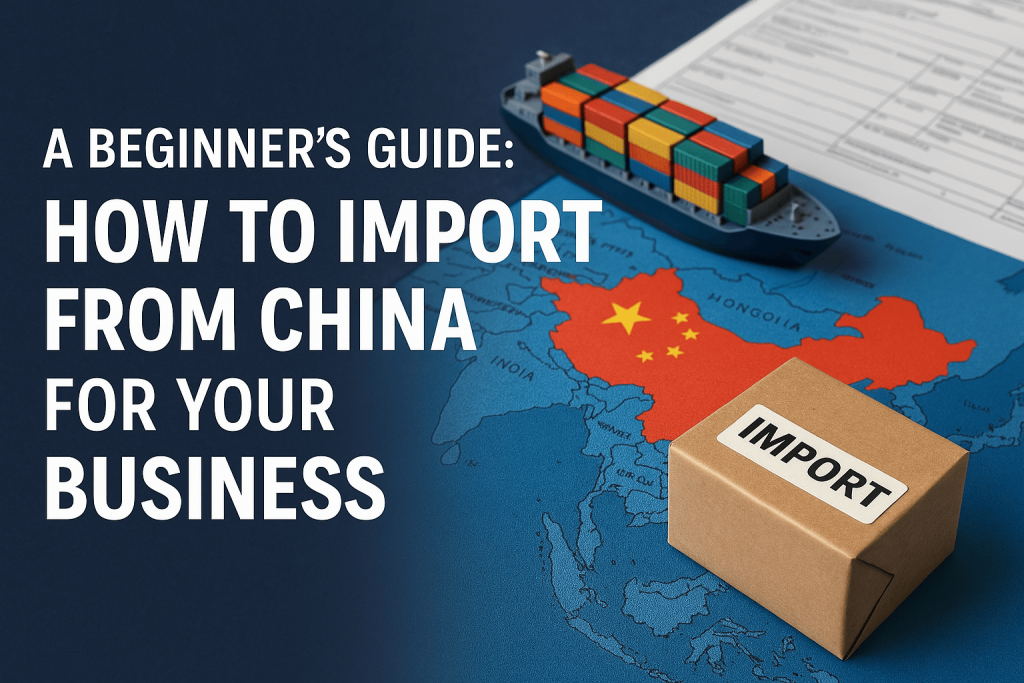If you’re considering expanding your business or finding new sources for your products, importing from China is one of the most effective ways to achieve that. China has long been a global leader in manufacturing and export, offering cost-effective solutions for businesses of all sizes. But how exactly do you go about importing from China? In this guide, we’ll walk you through the steps, tools, and strategies you need to know in order to successfully import products from China to your business.
Why You Should Consider Importing from China
When it comes to global sourcing, China plays a pivotal role. In 2024, the United States imported approximately $438.9 billion in goods from China. This accounts for a significant share—about 17.9%—of all U.S. imports. China offers a broad range of products, from electronics to machinery to textiles, which makes it an attractive sourcing option for businesses looking to get high-quality products at competitive prices.
China also holds a price advantage. For many products, China is the most cost-effective source, surpassing other major trading partners like Canada and Mexico. Despite global trade tensions, businesses continue to rely on Chinese imports because of the country’s unmatched manufacturing capacity and cost efficiency.

Step 1: Understand the Legalities of Importing from China
Before diving into importing from China, it’s essential to understand the legalities involved. There are a number of regulations and requirements you must adhere to when bringing goods into your country. Below are a few key points to consider:
1. Customs Compliance
U.S. businesses must comply with the rules set by U.S. Customs and Border Protection (CBP). This includes submitting the necessary paperwork, paying duties and taxes, and ensuring that all products meet U.S. standards. Ignoring these regulations can lead to delays or fines, so it’s important to ensure your shipments are compliant.
2. Tariffs and Trade Restrictions
One challenge of importing from China is the fluctuating tariffs. Due to trade tensions between the U.S. and China, tariffs on certain products can change frequently. For example, there has been an increase in tariffs on electronics and machinery. You should keep an eye on these changes to calculate the true cost of importing your products. A tariff can significantly impact your final pricing and profitability.
3. Import Licensing and Permits
Some products require specific licenses or permits to be imported. This is common with regulated items like electronics, medical devices, and food products. Be sure to verify whether your product category requires any special permits from authorities like the Food and Drug Administration (FDA) or Federal Communications Commission (FCC).
Step 2: Find Reliable Chinese Suppliers
Choosing a reliable supplier is one of the most important steps in the process of importing from China. With a large number of suppliers available, it can be overwhelming to determine who is trustworthy and who will deliver quality products. Here’s how to approach supplier selection:
1. Research and Use Online Platforms
There are several platforms where you can find manufacturers and suppliers in China. Websites like Alibaba, Made-in-China, and Global Sources are popular choices that allow you to view a wide range of products and suppliers. These platforms offer reviews, ratings, and verification details to help you make informed decisions.
2. Request Samples
Before committing to a large order, it’s essential to request product samples. This allows you to check the quality of the products firsthand and ensure they meet your standards. This step is crucial to avoid surprises when the full shipment arrives.
3. Use Third-Party Services for Verification
It’s a good idea to use third-party services for supplier verification. Services like Panjiva, Import Genius, and Flexport provide trade data that can help you verify the legitimacy of your supplier. You can also hire a third-party inspection company to check the products before shipment to ensure they meet your quality and compliance standards.
Step 3: Understand the Costs of Importing from China
Importing goods from China can offer significant cost savings, but it’s important to consider all the associated expenses. Below are some of the main costs you should account for:
1. Product Cost
This is the price you’ll pay for the products themselves, and it can vary depending on the type of product, the supplier, and the order quantity. In general, ordering larger quantities can help reduce the cost per unit.
2. Shipping and Freight Charges
Shipping costs can make a significant impact on your bottom line. You’ll need to decide between different shipping methods—air freight, sea freight, or land freight. Sea freight is typically cheaper but takes longer, while air freight is faster but more expensive. Freight forwarders can help manage the logistics, including negotiating with shipping companies and handling the paperwork.
3. Customs Duties and Taxes
Customs duties are taxes imposed by the government on imported goods. These can vary depending on the product category and its country of origin. Be sure to check the applicable duty rates and factor them into your cost calculations.
4. Tariffs
As mentioned earlier, tariffs are taxes imposed on specific imports, and these can change due to trade disputes. For example, the U.S. has imposed tariffs on many Chinese goods, which can make products more expensive. It’s important to monitor tariff updates to avoid unexpected increases in your costs.
Step 4: Shipping and Logistics
Once you’ve finalized your supplier and agreed on the terms, you’ll need to arrange for shipping and logistics. Here’s what to consider:
1. Choose a Freight Forwarder
A freight forwarder is a third-party service provider that can manage the shipping of your products from China to your country. They’ll take care of the transportation, handle all documentation, and ensure compliance with customs regulations.
2. Track Your Shipments
Using tools like Flexport or Zepol will give you real-time visibility into your shipments. This is especially important for tracking delays or potential issues during transit. These platforms provide shipment tracking and help you stay on top of the logistics process.
3. Delivery and Receiving
Once your goods have arrived, make sure to inspect the shipment thoroughly. Any discrepancies between the order and the delivered goods should be reported immediately. Ensure that your inventory is recorded and processed accurately to prevent mistakes that could affect your business operations.
Step 5: Build Strong Relationships with Your Supplier
Building long-term, positive relationships with your supplier in China can help ensure smooth and successful transactions in the future. Effective communication, clear expectations, and mutual trust are key to maintaining a good relationship. Be open to negotiation on pricing, delivery terms, and other conditions to establish a partnership that benefits both sides.

Conclusion: How to Import from China Made Simple
Importing from China may seem daunting, but breaking it down into manageable steps can help you succeed. Understanding the legalities, finding reliable suppliers, accounting for all costs, and managing logistics are all crucial to running a smooth import process. By following the steps outlined in this guide, you’ll be well-equipped to source products from China efficiently and cost-effectively.
As businesses continue to rely on Chinese imports for everything from electronics to textiles, knowing how to import from China will give your business the competitive edge you need to succeed in the global marketplace. Start with the basics, do your research, and build strong relationships with your suppliers to ensure your imports meet the highest standards and serve your business needs effectively.

